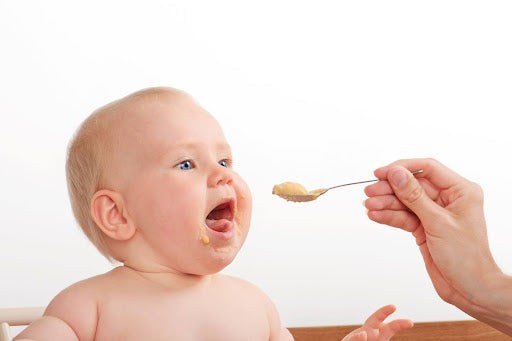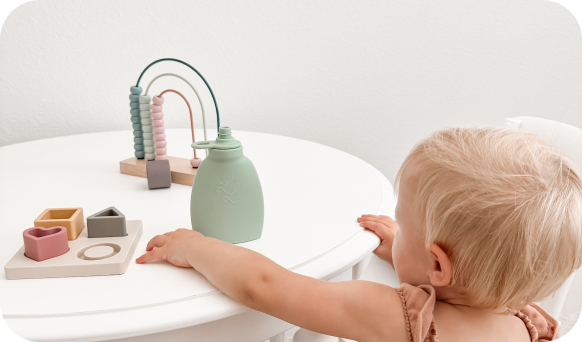First Foods for Your Baby: Starting Solids with Confidence

Introducing solids to your Little one is a pretty exciting time. It's about more than just the food—it's about watching them grow, learn, and start to explore the world around them through taste and texture. Think of it as the next chapter in their big adventure of "firsts."
But I get it, knowing how to start can feel overwhelming.
Essential Takeaways:
-
Identifying the Right Time to Start Solids: Knowing when to start your baby on solids is the first step in this new stage of development. The ideal window is generally between 4 to 6 months when your baby can sit with some support and shows interest in the foods you're eating.
-
Spotting these signs is key to starting them off at the appropriate developmental moment, ensuring a healthy and happy introduction to new tastes and textures.
-
Make It Easier with Smart Feeding Tools: The transition to solids can be a breeze with the right feeding accessories. Opting for purees as the first step toward solids is a great choice, and when paired with innovative feeding tools like our reusable food pouches, you’re all set for a hassle-free, neat, and sustainable feeding experience.
So, let's break it down and make sure you've got all the info you need to make this transition as smooth as peanut butter (you know, the no-stir kind).
- Understanding Baby’s Readiness for First Foods
- Best First Foods for Baby
- Making Mealtime Safe and Enjoyable
- Transitioning to More Textured Foods
- The Role of Sustainable Baby Products in Mealtime
Understanding Baby’s Readiness for First Foods
Before you can even think about purees, spoons, and bibs, you’ll need to know how to recognize when your baby is actually ready to start solids. Every child is unique, but there are a few universal signs that indicate your baby might be ready.¹
Signs Your Baby is Ready for Solid Foods
First, look for physical signs. Can your baby sit up with minimal support? Do they have good head control? These milestones are important because they help your baby safely swallow foods. Alongside these development cues, you’ll likely notice a budding curiosity in your baby’s eyes every time you eat.¹ It’s as if they’re saying, “Hey, I want in on that!”
Understanding the Tongue-Thrust Reflex
Another less obvious sign is the diminishing “tongue-thrust” reflex. This is your baby's natural reaction to push objects out of their mouth to avoid choking. Over time, as they get ready for solids, this reflex fades, making it easier for them to accept and handle food.²
The Ideal Age to Introduce Solids
While your baby may seem eager to taste and touch solid foods, experts recommend waiting until your baby is at least 5 months old for their digestive system to properly handle new textures and nutrients.¹
Meet The Palmetto Pouch: Your Ally in Starting Solid Foods
At this stage, introducing our premium reusable baby food pouch, The Palmetto Pouch, can make the transition smoother. Specially designed for babies and toddlers, The Palmetto Pouch offers a safe, convenient way to introduce solids.
Its innovative spoon-lid combo, perfect size for Little hands, and anti-leak design make it an ideal choice for parents starting their baby on solids. Plus, its eco-friendly and non-toxic materials ensure a healthier start for your baby.
Best First Foods for Baby

When it's time to introduce solids, choosing the right first foods is key to a smooth transition. The goal is to offer your baby a variety of pureed fruits and vegetables, such as apples, pears, carrots, and sweet potatoes, which are gentle on their developing digestive system. Baby cereals, particularly those fortified with iron, are also excellent options to include in your baby’s new diet.
How to Make Integrating Nutritious Foods Easier
The Palmetto Pouch from Lowcountry Littles makes integrating these foods into your baby's diet easier than ever. These pouches let you serve these nutritious purees in a fun, mess-free way that's also appealing to your Little one.
Made for Little Hands and Mouths
The Palmetto Pouch is designed for small hands to grasp and for Little mouths to feed from, making mealtime a positive experience for both you and your baby. Since The Palmetto Pouch is reusable, it’s not only eco-friendly but also convenient for parents looking to simplify meal prep and feedings.
Making Mealtime Safe and Enjoyable
Creating a positive mealtime experience is essential for your baby's development and can help foster a lifelong healthy relationship with food. Here are some tips, including how The Palmetto Pouch from Lowcountry Littles can contribute to making mealtime both safe and enjoyable:
- Promote Self-Feeding: Designed for Little hands, The Palmetto Pouch encourages self-feeding. The unique spoon-lid combo allows for mess-free feeding by squeezing puree onto the spoon for easy feeding or using the spoon as an airtight lid to prevent spills.
- Use Colorful, Non-Toxic Baby Food Pouches: Babies are drawn to bright colors, making colorful feeding tools like The Palmetto Pouch an excellent choice for catching their attention and making mealtime more engaging.
- Choose Reusable and Eco-Friendly Options: The Palmetto Pouch is not only safe for your baby but also good for the environment. Its reusable design reduces waste and provides a sustainable option for mealtime.
- Ensure Easy Cleaning for Hygiene: The Palmetto Pouch features a design that's easy to clean, ensuring that you can maintain a hygienic feeding environment for your baby with minimal effort.
- Leak-Proof Design for Mess-Free Feeding: With its anti-leak design, The Palmetto Pouch ensures that mealtime remains mess-free, making it a stress-free experience for both parents and baby.
- Soft, Safe Materials: Crafted from food-grade silicone, The Palmetto Pouch is gentle on your baby's gums and safe for them to use, ensuring a worry-free mealtime.
- Variable Flow Control: The pouch's variable flow technology allows your baby to feed at their own pace, reducing the risk of choking and making it a safer option for infants transitioning to solids.
By incorporating these strategies with The Palmetto Pouch, you're setting the stage for a mealtime environment that's not only safe and joyful for your baby but also kind to the planet. This combination promises a nurturing feeding experience that supports your baby's development and your family's eco-friendly values.
Transitioning to More Textured Foods
As your baby becomes more accustomed to purees, transitioning to more textured foods is the next step in their dietary development. This transition is crucial for developing chewing skills and expanding their taste preferences. Here are some tips to make this shift smoother:
- Introduce Textures Gradually: Start with slightly thicker purees before moving to mashed foods with soft, small lumps. This gradual change helps your baby adjust without becoming overwhelmed.
- Offer Variety: Introduce a range of textures through different foods, such as soft-cooked vegetables, ripe fruits, and small pieces of soft meats, to encourage exploration and prevent food aversions.
- Encourage Self-Feeding: The Palmetto Pouch's soft silicone spout is gentle on baby’s gums, making it perfect for this transition. It allows your baby to safely explore more textured foods without the risk of hurting their sensitive gums. Plus, the spoon-lid combo facilitates mess-free feeding, allowing you to squeeze puree onto the spoon for easy feeding or use the spoon as an airtight lid to prevent spills—a convenient solution for both at home and on the go.
The journey from purees to more textured foods is an exciting time for both you and your baby, marking significant growth and exploration in their eating habits. Using tools like The Palmetto Pouch can greatly ease this transition, providing a gentle, safe, and enjoyable way for your baby to experience new textures and tastes.
With patience and the right approach, your Little one will soon be enjoying a wide variety of foods, setting the stage for healthy eating habits that will benefit them for years to come.
The Role of Sustainable Baby Products in Mealtime
In today's world, the importance of using eco-friendly and non-toxic products for baby’s meals cannot be overstated. Sustainable baby products are not only safer for our children but also for the environment.
Here’s why choosing products like The Palmetto Pouch from Lowcountry Littles is essential.
Safety First
Non-toxic, food-grade silicone pouches ensure that your baby is not exposed to harmful chemicals during mealtime, safeguarding their health and well-being.
Environmental Impact
By opting for reusable baby food pouches like The Palmetto Pouch, you’re contributing to reducing waste and conserving natural resources, aligning with a lifestyle that values sustainability.
Long-Term Health
Choosing eco-friendly products goes beyond immediate safety. It also contributes to the long-term well-being of your child. Products made from non-toxic, food-grade materials support a healthier gut microbiome, essential for nutrient absorption and immune system function.
Additionally, minimizing exposure to harmful chemicals early in life can foster optimal cognitive development, laying the foundation for better learning outcomes and mental health. By prioritizing eco-friendly products, you’re investing in your child’s holistic health and future potential.
Our Commitment to Sustainability
Lowcountry Littles is committed to sustainability and safety, offering products that are not only convenient and innovative but also eco-friendly. The Palmetto Pouch represents this commitment, designed to reduce your carbon footprint while providing a safe, efficient, and enjoyable mealtime experience for your Little one.
Embrace a Sustainable Future with The Palmetto Pouch
By opting for The Palmetto Pouch, you're not only ensuring a safe, enjoyable mealtime experience for your Little one but also contributing to a greener planet. Join us in making mealtime both a joyous occasion and a step toward sustainable living.
Ready to make mealtime safer, more enjoyable, and eco-friendly for your baby? Shop The Palmetto Pouch now and take the first step toward a sustainable future for your family.
References:
- Centers for Disease Control and Prevention. (2023). When, What, and How to Introduce Solid Foods. Retrieved from https://www.cdc.gov/nutrition/infantandtoddlernutrition/foods-and-drinks/when-to-introduce-solid-foods.html
- Healthline. (2018). What Is Extrusion Reflex? Retrieved from https://www.healthline.com/health/parenting/extrusion-reflex
